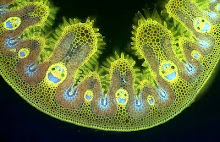Few spring flowers have such grace and elegance as Erythronium 'Pagoda', right from the time that the buds form to the moment when the sulphur yellow tepals open and curl backwards.
It's an easy plant to grow, thriving in permanently moist soil in the dappled shade of deciduous trees. The only problem is remembering where the bulbs have been planted after the flowers and foliage die back in summer - it's easy to forget and accidentally dig them up. Left undisturbed, it steadily increases forming very attractive carpets of spring foliage and flowers.
The genus Erythronium has a northern temperate distribution, with around twenty two species that are mostly found in deciduous woodlands. There is a very good series of Scottish Rock Garden Club articles by Ed Alverson describing the North American species in their natural habitat and including some very fine photographs, which you can access by clicking here, here, here, here, and here.
Erythronium is often called the trout lily or dog's tooth violet, the latter name referring to the tooth-like shape of the bulbs rather than the flowers. The name trout lily refers to the similarity between the mottling on the leaves and the skin markings of trout.
















